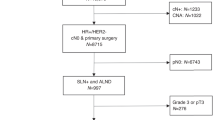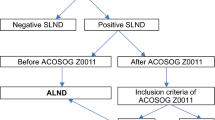Key Points
-
Axillary micrometastases require no further axillary treatment after SNB for patients with early stage breast cancer
-
After positive sentinel node biopsy, axillary irradiation provides equivalent regional control to nodal clearance in early breast cancer
-
Less morbidity (especially lymphoedema) is seen after axillary radiotherapy
-
Axillary dissection can be safely omitted in patients with more than two positive sentinel nodes after breast-conserving surgery, provided whole-breast radiation therapy is planned
Abstract
Although the majority of patients with breast cancer have clinically negative axillary nodes at preoperative assessment, around 15–20% of these women will have metastatic disease within the lymph nodes at operative sentinel node biopsy, and additional selective treatment to the axilla might be required. Local treatment to the axilla can include axillary node clearance or axillary radiotherapy. The recent results of the American College of Surgeons Oncology Group Z0011 trial suggested that some women would be safe from recurrence without further axillary treatment if they have less than three involved sentinel nodes, with no extracapsular spread. We review the evidence base for management of the axilla after detection of a positive sentinel node, discuss the evidence for why micrometastatic disease requires systemic but not axillary therapy, and present data suggesting that axillary irradiation for macrometastases gives equivalent control to axillary node clearance, but causes less morbidity such as lymphoedema. Ongoing trials will confirm whether any further therapy can be omitted for all patients with low volume, sentinel-node macrometastases.
This is a preview of subscription content, access via your institution
Access options
Subscribe to this journal
Receive 12 print issues and online access
$209.00 per year
only $17.42 per issue
Buy this article
- Purchase on Springer Link
- Instant access to full article PDF
Prices may be subject to local taxes which are calculated during checkout
Similar content being viewed by others
References
Mansel, R. E. et al. Randomized multicenter trial of sentinel node biopsy versus standard axillary treatment in operable breast cancer: the ALMANAC Trial. J. Natl Cancer Inst. 98, 599–609 (2006).
Krag, D. N. et al. Sentinel-lymph-node resection compared with conventional axillary-lymph-node dissection in clinically node-negative patients with breast cancer: overall survival findings from the NSABP B-32 randomised phase 3 trial. Lancet Oncol. 11, 927–933 (2010).
van der Ploeg, I. M., Nieweg, O. E., van Rijk, M. C., Valdés Olmos, R. A. & Kroon, B. B. Axillary recurrence after a tumour-negative sentinel node biopsy in breast cancer patients: a systematic review and meta-analysis of the literature. Eur. J. Surg. Oncol. 34, 1277–1284 (2008).
Straver, M. E. et al. Role of axillary clearance after a tumor-positive sentinel node in the administration of adjuvant therapy in early breast cancer. J. Clin. Oncol. 28, 731–737 (2010).
Dominick, S. A., Natarajan, L., Pierce, J. P., Madanat, H. & Madlensky, L. The psychosocial impact of lymphedema-related distress among breast cancer survivors in the WHEL study. Psychooncology http://dx.doi.org/10.1002/pon.3510.
Caretta-Weyer, H. et al. Impact of the American College of Surgeons Oncology Group (ACOSOG) Z0011 trial on clinical management of the axilla in older breast cancer patients: a SEER–Medicare analysis. Ann. Surg. Oncol. 20, 4145–4152 (2013).
Galimberti, V. et al. Axillary dissection versus no axillary dissection in patients with sentinel-node micrometastases (IBCSG 23–01): a phase 3 randomised controlled trial. Lancet Oncol. 14, 297–305 (2013).
Montagna, E. et al. Minimal axillary lymph node involvement in breast cancer has different prognostic implications according to the staging procedure. Breast Cancer Res. Treat. 118, 385–394 (2009).
De Boer, M. et al. Micrometastases or isolated tumor cells and the outcome of breast cancer. N. Engl. J. Med. 361, 653–663 (2009).
Schwartz, G. F., Giuliano, A. E. & Veronesi, U. Consensus Conference Committee. Proceedings of the consensus conference on the role of sentinel lymph node biopsy in carcinoma of the breast April 19 to 22, 2001, Philadelphia, Pennsylvania. Hum. Pathol. 33, 579–589 (2002).
Goldhirsch, A. et al. Personalizing the treatment of women with early breast cancer: highlights of the St. Gallen International Expert Consensus on the Primary Therapy of Early Breast Cancer 2013. Ann. Oncol. 24, 2206–2223 (2013).
Boughey, J. C. et al. Sentinel lymph node surgery after neoadjuvant chemotherapy in patients with node-positive breast cancer: the ACOSOG Z1071 (Alliance) clinical trial. JAMA 310, 1455–1461 (2013).
Axelsson, C. K., Mouridsen, H. T. & Zedeler, K. Axillary dissection of level I and II lymph nodes is important in breast cancer classification. The Danish Breast Cancer Cooperative Group (DBCG). Eur. J. Cancer 28A, 1415–1418 (1992).
Orr, R. K. The impact of prophylactic axillary node dissection on breast cancer survival—a Bayesian meta-analysis. Ann. Surg. Oncol. 6, 109–116 (1999).
Krag, D. N. & Single, R. M. Breast cancer survival according to number of nodes removed. Ann. Surg. Oncol. 10, 1152–1159 (2003).
Lyman, G. H. et al. American Society of Clinical Oncology guideline recommendations for sentinel lymph node biopsy in early-stage breast cancer. J. Clin. Oncol. 23, 7703–7720 (2005).
Lyman, G. H. et al. Sentinel lymph node biopsy for patients with early-stage breast cancer: American Society of Clinical Oncology clinical practice guideline update. J. Clin. Oncol. 32, 1365–1383 (2014).
Giuliano, A. E. et al. Axillary dissection vs no axillary dissection in women with invasive breast cancer and sentinel node metastasis: a randomized clinical trial. JAMA 305, 569–575 (2011).
Simone, N. L. et al. Twenty-five year results of the National Cancer Institute randomized breast conservation trial. Breast Cancer Res. Treat. 132, 197–203 (2012).
Hunt, K. K. et al. Factors associated with local-regional recurrence after a negative sentinel node dissection: results of the ACOSOG Z0010 trial. Ann. Surg. 256, 428–436 (2012).
Giuliano, A. E. et al. Locoregional recurrence after sentinel lymph node dissection with or without axillary dissection in patients with sentinel lymph node metastases: the American College of Surgeons Oncology Group Z0011 randomized trial. Ann. Surg. 252, 426–432 (2010).
Lowery, A. J., Kell, M. R., Glynn, R. W., Kerin, M. J. & Sweeney, K. J. Locoregional recurrence after breast cancer surgery: a systematic review by receptor phenotype. Breast Cancer Res. Treat. 133, 831–841 (2012).
Fisher, B. et al. Twenty-five-year follow-up of a randomized trial comparing radical mastectomy, total mastectomy, and total mastectomy followed by irradiation. N. Engl. J. Med. 347, 567–575 (2002).
Mamounas, E. P. et al. Association between the 21-gene recurrence score assay and risk of locoregional recurrence in node-negative, estrogen receptor-positive breast cancer: results from NSABP B-14 and NSABP B-20. J. Clin. Oncol. 28, 1677–1683 (2010).
Louis-Sylvestre, C. et al. Axillary treatment in conservative management of operable breast cancer: dissection or radiotherapy? Results of a randomized study with 15 years of follow-up. J. Clin. Oncol. 22, 97–101 (2004).
Goyal, A., Newcombe, R. G., Chhabra, A. & Mansel, R. E. Factors affecting failed localisation and false-negative rates of sentinel node biopsy in breast cancer—results of the ALMANAC validation phase. Breast Cancer Res. Treat. 99, 203–208 (2006).
Cserni, G. et al. Meta-analysis of non-sentinel node metastases associated with micrometastatic sentinel nodes in breast cancer. Br. J. Surg. 91, 1245–1252 (2004).
EBCTCG Early Breast Cancer Trialists' Collaborative Group. Effect of radiotherapy after mastectomy and axillary surgery on 10-year recurrence and 20-year breast cancer mortality: meta-analysis of individual patient data for 8135 women in 22 randomised trials. Lancet 383, 2127–2135 (2014).
Giuliano, A. E. et al. Association of occult metastases in sentinel lymph nodes and bone marrow with survival among women with early-stage invasive breast cancer. JAMA 306, 385–393 (2011).
Fisher, B. et al. Sequential methotrexate and fluorouracil for the treatment of node-negative breast cancer patients with estrogen receptor-negative tumors: eight-year results from National Surgical Adjuvant Breast and Bowel Project (NSABP) B-13 and first report of finding. J. Clin. Oncol. 14, 1982–1992 (1996).
Fisher, B. et al. Five versus more than five years of tamoxifen therapy for breast cancer patients with negative lymph nodes and estrogen receptor-positive tumors. J. Natl Cancer Inst. 88, 1529–1542 (1996).
Early Breast Cancer Trialists' Collaborative Group (EBCTCG). Effects of chemotherapy and hormonal therapy for early breast cancer on recurrence and 15-year survival: an overview of the randomised trials. Lancet 365, 1687–1717 (2005).
Perez, E. A. et al. Four-year follow-up of trastuzumab plus adjuvant chemotherapy for operable human epidermal growth factor receptor 2-positive breast cancer: joint analysis of data from NCCTG N9831 and NSABP B-31. J. Clin. Oncol. 29, 3366–3373 (2011).
Donker, M. et al. Comparison of the sentinel node procedure between patients with multifocal and unifocal breast cancer in the EORTC 10981–22023 AMAROS trial: identification rate and nodal outcome. Eur. J. Cancer 49, 2093–2100 (2013).
Freeman, S. R. et al. Long term results of a randomised prospective study of preservation of the intercostobrachial nerve. Eur. J. Surg. Oncol. 29, 213–215 (2003).
Fleissig, A. et al. Post-operative arm morbidity and quality of life. Results of the ALMANAC randomised trial comparing sentinel node biopsy with standard axillary treatment in the management of patients with early breast cancer. Breast Cancer Res. Treat. 95, 279–293 (2006).
DiSipio, T., Rye, S., Newman, B. & Hayes, S. Incidence of unilateral arm lymphoedema after breast cancer: a systematic review and meta-analysis. Lancet Oncol. 14, 500–515 (2013).
Goyal, A. 'POSNOC Trial (Positive Sentinel Lymph Node: Observation vs. Clearance): a randomised trial of axillary lymph node dissection in women with T1 or T2 N0 M0 breast cancer who have a positive sentinel node' in Association of Breast Surgery Yearbook 2012 72–73 (Association of Breast Surgery, The Royal College of Surgeons, 2012).
Rouzier, R. et al. Breast cancer molecular subtypes respond differently to preoperative chemotherapy. Clin. Cancer Res. 11, 5678–5685 (2005).
Carey, L. A. et al. The triple negative paradox: primary tumor chemosensitivity of breast cancer subtypes. Clin. Cancer Res. 13, 2329–2334 (2007).
Kuehn, T. et al. Sentinel-lymph-node biopsy in patients with breast cancer before and after neoadjuvant chemotherapy (SENTINA): a prospective, multicentre cohort study. Lancet Oncol. 14, 609–618 (2013).
NSABP© National Surgical Adjuvant Breast and Bowel Project [online], (2014).
US National Library of Medicine. ClinicalTrials.gov [online], (2014).
US National Library of Medicine. ClinicalTrials.gov [online], (2013).
Author information
Authors and Affiliations
Contributions
All authors made substantial contributions to all stages of the preparation of the manuscript for submission.
Corresponding author
Ethics declarations
Competing interests
The authors declare no competing financial interests.
PowerPoint slides
Rights and permissions
About this article
Cite this article
Bundred, N., Barnes, N., Rutgers, E. et al. Is axillary lymph node clearance required in node-positive breast cancer?. Nat Rev Clin Oncol 12, 55–61 (2015). https://doi.org/10.1038/nrclinonc.2014.188
Published:
Issue Date:
DOI: https://doi.org/10.1038/nrclinonc.2014.188
This article is cited by
-
The necessity of IIb dissection in T1–T2N0M0 oral squamous cell carcinoma: protocol for a randomized controlled trial
Trials (2019)
-
A logistic regression model predicting high axillary tumour burden in early breast cancer patients
Clinical and Translational Oncology (2017)



